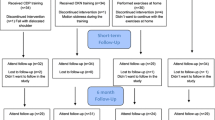Abstract
Patients with unilateral vestibular lesions have a set of deficits requiring compensation based on the inherent plasticity of the central nervous system. In the 1940s, it was reported that patients with unilateral vestibular dysfunctions who exercised recovered faster than those who did not. The present prospective, randomized investigation aimed to assess the role of a computerized posturography-assisted early vestibular rehabilitation protocol combined with a home-based exercise program in the treatment of patients with unilateral peripheral vestibular disorders occurring 2 weeks previously. Fifteen patients were randomly assigned to a 5-week posturography-assisted vestibular rehabilitation protocol and a home-based exercise program (Group A), while 15 simply awaited spontaneous compensation (Group B). All patients underwent computerized posturography approximately 2 weeks after their vestibular disorder was diagnosed and again after 6 weeks. Ten healthy volunteers were also studied (Group C). After rehabilitation, Group A patients improved significantly in most sensory measures [modified clinical test of sensory organization and balance (mCTSIB)] and motor parameters [limits of stability (LOS)] by comparison with preliminary outcomes, and there were no significant differences in sensory (mCTSIB) and motor (LOS) findings between Group A and the healthy volunteers. At the same time point, several motor (LOS) parameters were still altered in Group B by comparison with the healthy volunteers. These preliminary outcomes support the hypothesis that the compensation achievable after 6 weeks with a customized program of posturography-assisted vestibular rehabilitation and home-based exercises is superior to the results of physiological spontaneous compensation.




Similar content being viewed by others
References
Bamiou DE, Davies RA, McKee M, Luxon LM (1999) The effect of severity of unilateral vestibular dysfunction on symptoms, disabilities and handicap in vertiginous patients. Clin Otolaryngol Allied Sci 24:31–38
Baloh RW, Honrubia V (2001) Clinical neurophysiology of the vestibular system. Oxford University Press, New York
Hahn A, Sejna I, Stolbova K, Cocek A (2001) Visuo-vestibular biofeedback in patients with peripheral vestibular disorders. Acta Otolaryngol Suppl 545:88–91
Cawthorne T (1946) Vestibular injuries. Proc Royal Soc Med 39:270–273
Cooksey FS (1946) Rehabilitation in vestibular injuries. Proc Roy Soc Med 39:273–278
Rossi-Izquierdo M, Santos-Perez S, Soto-Varela A (2011) What is the most effective vestibular rehabilitation technique in patients with unilateral peripheral vestibular disorders? Eur Arch Otorhinolaryngol 268:1569–1574
Hillier SL, McDonnell M (2011) Vestibular rehabilitation for unilateral peripheral vestibular dysfunction. Cochrane Database Syst Rev 2:CD00539
Guidetti G (1997) Diagnosi e terapia dei disturbi dell’equilibrio. Editore Marrapese, Roma
Topuz O, Topuz B, Ardiç FN, Sarhuş M, Ogmen G, Ardiç F (2004) Efficacy of vestibular rehabilitation on chronic unilateral vestibular dysfunction. Clin Rehabil 18:76–83
Strupp M, Arbusow V, Maag KP, Gall C, Brandt T (1998) Vestibular exercises improve central vestibulospinal compensation after vestibular neuritis. Neurology 51:838–844
Chaudhry H, Bukiet B, Ji Z, Findley T (2011) Measurement of balance in computer posturography: Comparison of methods—A brief review. J Bodyw Mov Ther 15:82–91
Mbongo F, Patko T, Vidal PP, Vibert N, Tran Ba Huy P, de Waele C (2005) Postural control in patients with unilateral vestibular lesions is more impaired in the roll than in the pitch plane: a static and dynamic posturography study. Audiol Neurootol 10:291–302
Clarke AH (2010) Laboratory testing of the vestibular system. Curr Opin Otolaryngol Head Neck Surg 18:425–430
Cakrt O, Chovanec M, Funda T, Kalitová P, Betka J, Zverina E, Kolár P, Jerábek J (2010) Exercise with visual feedback improves postural stability after vestibular schwannoma surgery. Eur Arch Otorhinolaryngol 267:1355–1360
Teggi R, Caldirola D, Fabiano B, Recanati P, Bussi M (2009) Rehabilitation after acute vestibular disorders. J Laryngol Otol 123:397–402
Acknowledgments
This study was partly supported by grant no. 60A07-9312/10 from the University of Padova, Italy. The authors thank Cristina Tabellini, MD for data collecting, Frances Coburn for correcting the English final version of this paper, and Roberta Andreose for her photographic contribution.
Conflict of interest
The authors have no conflict of interest to declare.
Author information
Authors and Affiliations
Corresponding author
Additional information
In December 2009, a preliminary version of the present study won the prize for the best final thesis in northeastern Italy for the university degree course in Physical Therapy.
Rights and permissions
About this article
Cite this article
Marioni, G., Fermo, S., Zanon, D. et al. Early rehabilitation for unilateral peripheral vestibular disorders: a prospective, randomized investigation using computerized posturography. Eur Arch Otorhinolaryngol 270, 425–435 (2013). https://doi.org/10.1007/s00405-012-1944-4
Received:
Accepted:
Published:
Issue Date:
DOI: https://doi.org/10.1007/s00405-012-1944-4




